2. 石家庄印钞有限公司, 石家庄 050031;
3. 北京大学城市与环境学院, 北京 100871
2. Shijiazhuang Banknote Printing Co., Ltd., Shijiazhuang 050031, China;
3. College of Urban and Environmental Sciences, Peking University, Beijing 100871, China
硝基多环芳烃(nitrated polycyclic aromatic hydrocarbons, NPAHs)是一类通过硝基取代的多环芳烃(polycyclic aromatic hydrocarbons, PAHs)的衍生物.毒理试验表明, NPAHs与其母体PAHs相比, 致突变性可高达10万倍, 致癌性也能达到10倍[1]. NPAHs主要来自一次排放或者二次形成, 其中一次排放源主要有燃烧源和柴油车尾气等, 二次形成源是由母体PAHs与·OH、NO3和O3等氧化剂发生大气光化学反应而形成[2~4].随着工业的快速发展和城市化进程的不断加快, 尤其是汽车保有量的逐年增加, 逐年升高的NOx与VOCs (volatile organic compounds)前体物排放也给诸多区域带来了以较高浓度臭氧及雾-霾污染天气为特征的、较严重的区域大气光化学反应的发生, 也使得大气NPAHs浓度逐年升高, 对区域居民造成一定的潜在健康风险[5~7].由此也引起了国内外众多学者对大气硝基多环芳烃的关注[8].
近年来, 有较多国内学者对部分城市大气中NPAHs的污染现状进行了较深入细致地研究.杨丹[9]报道了2011年东莞市6个不同功能区(居民区、居民商业区、隧道、交通枢纽区、交通工业区及工业区)大气颗粒物(PM2.5和PM10)中6种NPAHs的浓度水平以及致癌风险, 结果表明NPAHs最高浓度出现在隧道空气中, 且致癌风险值较高.林刚等[10]对抚顺大气颗粒物PM2.5、PM10中NPAHs的冬夏季浓度进行了观测研究, 结果表明冬季以2-硝基荧蒽(2-nitrofluoranthene, 2N-FLA, 二次形成标识物)为主要组分, 夏季以2-硝基芘(2-nitropyrene, 2N-PYR, 二次形成标识物)为主要组分.还有研究发现:河北农村大气中NPAHs浓度水平较高, 推测主要来自生物质燃料的燃烧[11].
国外较多学者主要针对大气NPAHs浓度水平以及一次排放及二次形成的来源识别进行了相关的深入研究:Valle-Hernández等[12]观测了墨西哥大气中8种NPAHs组分浓度的季节变化和NPAHs与常规污染物如NOx和O3等之间的相关性, 研究表明研究区大气中NPAHs既有一次排放源, 也有二次形成源, 其中大气PM2.5中8种NPAHs浓度变化范围为58~383 pg·m-3, PM10中8种NPAHs浓度变化范围为111~819 pg·m-3. Kameda等[13]也研究了日本大阪大气中5种NPAHs的季节变化, 结果表明一次排放标识物1-硝基芘(1-nitropyrene, 1N-PYR)在交通区和住宅区的浓度均为冬季高于夏季, 而夏季二次形成标识物2N-FLA和2N-PYR浓度高于冬季.
近年来大量流行病学研究也证实了可吸入颗粒物PM2.5浓度的增加与肺癌密切相关[14]. NPAHs与母体PAHs一起吸附于PM2.5上, 危害更为严重.由此可见, 研究大气PM2.5中NPAHs的污染特征及呼吸暴露风险具有十分重要的意义, 可为大气NPAHs污染的控制、治理和降低肺癌风险提供科学数据.
宁东能源化工基地是能源金三角的重要组成部分, 其中煤炭开采、火力发电和煤炭深加工是宁东基地的三大重要产业.因此宁东地区能源和资源产业持续开发将不可避免地造成宁东地区的大气NPAHs污染.本文旨在研究中国西部典型能源化工基地大气PM2.5中NPAHs的浓度水平及其时空污染特征, 并结合NPAHs族谱特征及Σ12NPAHs/Σ16PAHs比值对宁东能源化工基地NPAHs的一次排放源和二次形成源的贡献进行初步解析.并基于观测数据, 采用等效BaP浓度的方法[14], 对宁东能源化工基地大气PM2.5中Σ5NPAHs对研究区人群造成的呼吸暴露肺癌风险值进行估算, 评估该研究区人群潜在的NPAHs呼吸暴露肺癌风险.
1 材料与方法 1.1 采样点布设及样品采集(1) 采样点布设本研究选择宁东能源化工基地作为研究区, 选择了不同产业类型的两个采样点分别位于宁东宝丰能源工业园和国电英力特宁东煤基多联产化学工业园(宝丰:主要以煤炭能源排放为主, 英力特:主要以化工生产活动排放为主), 如图 1所示.

|
图 1 采样点位置示意 Fig. 1 Locations of the sampling sites |
(2) 样品采集使用大流量PM2.5主动采样器(ASM-1, 广州铭野环保科技有限公司)采样流量为300 L·min-1, 采样时间段分别为2016年7月17~30日(夏季)和2016年12月30日~2017年1月16日(冬季), 其中全天(23 h, 每天从上午09:00点至次日上午08:00点)采样时间段为:2016年7月17~23日以及2016年12月30日~2017年1月5日.昼夜采样(11 h, 09:00~20:00和21:00~次日08:00)时间段为:2016年7月24~30日和2017年1月10~16日.
1.2 采样石英滤膜处理及保存本研究使用18.0 cm×10.5 cm的石英滤膜采集PM2.5样品.采样前, 将石英滤膜在马弗炉中以450℃的温度灼烧4 h, 之后于干燥器中室温平衡24 h, 最后于十万分之一精度天平上称重.采样时, 使用浸渍无水乙醇的脱脂棉擦拭过的镊子夹取石英滤膜, 并将其放置在采样器中的滤膜撑上; 采样结束后, 将采集到细颗粒物样品一面的石英滤膜向内对折, 放入干燥器中平衡24 h之后再次称重, 最后放入-20℃的冰箱中冷冻储存直至分析.
1.3 样品前处理:(1) 索氏提取将采有PM2.5样品的石英滤膜置于索氏提取器中, 加入约80 mL的二氯甲烷, 同时加入200 ng NPAHs回收率指示剂(6-硝基䓛-d11和9-硝基蒽-d9)和1 000 ng PAHs回收率指示剂(5种氘代PAHs), 提取24 h.
(2) 旋转蒸发转移索提的80 mL抽提液在旋转蒸发仪中进一步浓缩至2 mL左右, 用正己烷转置浓缩至大约1 mL.
(3) 分离净化将浓缩液通过中性无水Na2SO4-SiO2-Al2O3层析柱净化, 首先用二氯甲烷/正己烷的混合液(体积比1:1)淋洗层析柱, 再用二氯甲烷淋洗该层析柱, 总共收集40 mL淋洗液, 用氮气吹脱淋洗液使其浓缩至约0.5 mL, 最后转移至1.5 mL的进样瓶中, 在内插衬管中进一步浓缩至约100 μL, 并加入200 ng的3-硝基荧蒽-d9和200 ng六甲基苯分别作NPAHs和PAHs的内标物, 待上机测定.
1.4 GC-MS分析利用GC-MS(Thermo Fisher Trace 1300 GC-ISQ LT)对NPAH和PAHs进行定量分析, 色谱柱为TD-5MS (30 m×0.25 mm×0.25 μm), 以高纯氦气为载气.离子源均为EI模式.
NPAHs定量分析GC-MS仪器条件:进样口温度280℃, 离子源温度280℃, 传输线温度300℃.恒流1.2 mL·min-1, 不分流进样2 μL.色谱柱升温程序:初始温度60℃(1 min), 后以45℃·min-1升温至150℃, 再以5℃·min-1升温至300℃(15 min).以选择离子流模式(selected ion mode, SIM)检测提取液中的NPAHs目标化合物, 内标法定量NPAHs的含量.
PAHs定量分析GC-MS仪器条件:进样口温度280℃, 离子源温度250℃, 传输线温度280℃.恒流1.5 mL·min-1, 不分流进样1 μL.色谱柱升温程序:初温80℃(5 min), 20℃·min-1升温至100℃, 2℃·min-1升温至290℃(5 min).同样以SIM模式检测提取液中的PAHs目标化合物, 内标法定量PAHs的含量.
本研究中12种目标NPAHs分别为:1-硝基萘(1-nitro-napthalene, 1N-NAP)、2-硝基萘(2-nitro-napthalene, 2N-NAP)、5-硝基苊(5-nitro-acenaphthene, 5N-ACE)、2-硝基芴(2-nitro-fluorene, 2N-FLO)、2-硝基蒽(2-nitro-anthracene, 2N-ANT)、9-硝基蒽(9-nitro-anthracene, 9N-ANT)、9-硝基菲(3-nitro-phenanthrene, 9N-PHE)、3-硝基菲(3-nitro-phenanthrene, 3N-PHE)、2-硝基荧蒽(2-nitro-fluoranthene, 2N-FLA)、1-硝基芘(1-nitro-pyrene, 1N-PYR)、7-硝基苯并[a]蒽(7-nitro-benz[a]anthracene, 7N-BaA)和6-硝基(6-nitro-chrysene, 6N-CHR). 16种美国国家环保局优先控制的目标PAHs如下:萘(napthalene, NAP)、苊烯(acenaphthylene, ACY)、苊(acenaphthene, ACE)、芴(fluorene, FLU)、菲(phenanthrene, PHE)、蒽(anthracene, ANT)、荧蒽(fluoranthene, FLA)、芘(pyrene, PYR)、苯并[a]蒽(benz[a]anthracene, BaA)、(chrysene, CHR)、苯并[b]荧蒽(benzo[b]fluoranthene, BbF)、苯并[k]荧蒽(benzo[k]fluoranthene, BkF)、苯并[a]芘(benzo[a]pyrene, BaP)、茚苯[1, 2, 3-cd]芘(indeno[1, 2, 3-cd]pyrene, IP)、二苯并[a, h]蒽(dibenzo(a, h)anthracene, DiB)和苯并[ghi]苝(benzo[ghi]perylene, BghiP).
1.5 质量保证/质量控制(QA/QC)(1) 样品采集阶段质量保证/控制每次采样之前清理切割器, 每一样品采集完毕, 将采集到颗粒物的膜面朝内对折, 然后使用铝箔纸密封, 放入冰箱冷冻保存.
(2) 样品回收率在索提环节中加入已知量NPAHs及PAHs的回收率指示剂, 以此确定其在样品中的回收水平.本研究的所有样品回收率均在60%以上.
(3) 野外空白与实验室空白野外空白石英滤膜带入相应采样地点, 采样结束后带回实验室. GC-MS测定时每10个样品为一组, 每组样品有一个实验室空白.分析结果表明, 空白样品中NPAHs及PAHs含量均低于样品含量的10%.
(4) 仪器检出限与方法检出限仪器检出限为在一定的置信区间内, 能够与仪器噪声相区别的检测信号所对应的最小浓度, 通常GC-MS检出限为信噪比为3:1时所对应的标样浓度, 本研究的12种NPAHs的仪器检出限在0.5~5 ng·mL-1之间. 16种PAHs仪器检出限范围为5~30 ng·mL-1.方法检出限为连续测定3个空白, 平均空白浓度再加上其3倍标准偏差即为方法检出限.本研究的12种NPAHs方法检出限为2.1~9.6 ng. 16种PAHs方法检出限为3.5~20 ng.
2 结果与讨论 2.1 PM2.5中NPAHs浓度水平 2.1.1 PM2.5中NPAHs浓度水平的空间分布和季节差异图 2为2016年宝丰和英力特2个采样点PM2.5中Σ12NPAHs浓度水平的季节特征.从中可见, 宝丰冬季Σ12NPAHs的浓度范围为17.79~37.14 ng·m-3 [平均浓度为(25.57±5.76)ng·m-3], 夏季Σ12NPAHs的浓度范围为5.21~8.18 ng·m-3 [平均浓度为(6.22±1.74) ng·m-3].英力特冬季Σ12NPAHs的浓度范围为4.76~9.24 ng·m-3 [平均浓度为(7.13±1.44) ng·m-3], 夏季Σ12NPAHs的浓度范围为2.05~3.15 ng·m-3 [平均浓度为(2.58±0.39) ng·m-3].宝丰冬季Σ12NPAHs平均浓度是夏季的4.11倍, 英力特冬季Σ12NPAHs平均浓度是夏季的2.76倍.宝丰和英力特PM2.5中Σ12NPAHs的浓度均表现出冬季高于夏季的特征, 推测可能的原因为冬季取暖造成NPAHs一次排放增多.宝丰采样点冬夏季Σ12NPAHs浓度水平均明显高于英力特, 推测与宝丰的煤炭开采及焦炭生产的能源产业较化工产业造成更高的NPAHs一次排放相关, 而造成了Σ12NPAHs浓度在两个不同产业类型的工业园区空间的分布差异.
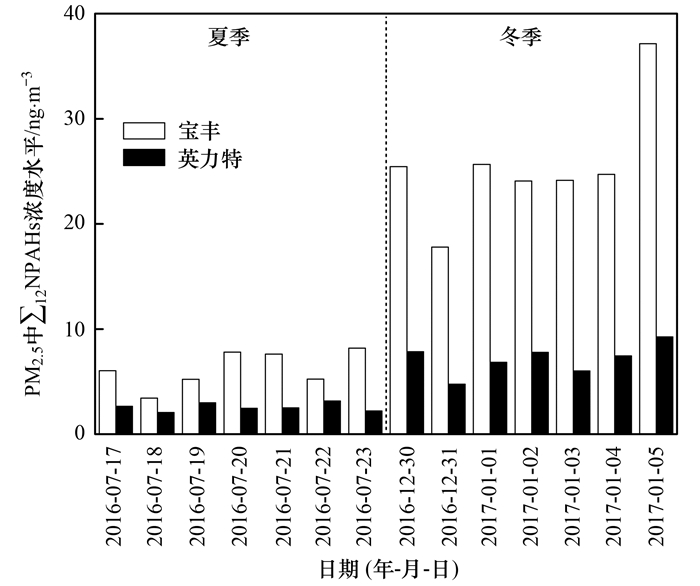
|
图 2 2016年宝丰和英力特PM2.5中Σ12NPAHs浓度水平的季节特征 Fig. 2 Seasonal characteristics of concentration levels of Σ12NPAHs in PM2.5 at Baofeng and Yinglite for 2016 |
表 1为宁东能源化工基地PM2.5中Σ12NPAHs浓度与国内外部分城市与地区PM2.5中ΣNPAHs浓度对比结果.从中可以看出, 宁东能源化工基地PM2.5中Σ12NPAHs浓度水平基本高于国内外城市较多, 其中宝丰采样点冬季最高浓度约为英国伯明翰市冬季最高浓度的3倍, 夏季最高浓度约为巴西阿雷格里港市的夏季最高浓度的2.8倍.英力特采样点冬季最高浓度(9.24 ng·m-3)要稍低于英国伯明翰市冬季最高浓度(11.70 ng·m-3), 夏季最高浓度(3.15 ng·m-3)要稍高于巴西阿雷格里港市夏季最高浓度(2.90 ng·m-3).宝丰和英力特采样点和国内其他城市比较居于较高的污染水平:宝丰采样点冬季最高浓度约为西安最高浓度的7倍.英力特采样点冬季浓度稍高于西安, 但都处于一个数量级水平.宝丰和英力特采样点冬季比中国南方城市冬天高约1~2个数量级, 而夏季高出北京, 上海夏季1~2个数量级.由此可见, 宁东能源化工基地的能源化工产业活动造成了较高的NPAHs排放.本研究不足之处在于没有对宁东能源基地周边地区如:背景点及城区点进行浓度水平观测, 因而只与以上国内外城市或地区生活区或交通区浓度水平进行了对比.
|
|
表 1 宁东能源化工基地PM2.5中Σ12NPAHs浓度与国内外城市对比 Table 1 Concentration comparisons of Σ12NPAHs in PM2.5 at the Ningdong energy and chemical industry base with available data for PM2.5-bound NPAHs domestically and overseas |
2.2 PM2.5中NPAHs浓度水平的夜昼差异
大气NPAHs的夜昼浓度差异可以用来初步判断其来源是否存在二次形成的贡献. 图 3显示了宝丰和英力特两采样点冬夏两季PM2.5中Σ12NPAHs夜间浓度与日间浓度的比值(夜昼比)特征.从中可以看出夏季PM2.5中Σ12NPAHs浓度的夜昼比比值在大部分采样天数低于1(日间高于夜间), 而冬天则大部分高于1(夜间高于日间), 推测主要由于夏季日间温度高, 大气光化学反应较夜间更活跃, 从而贡献了更多的日间二次形成的NPAHs.但2016年的7月28日和7月30日这2 d的观测数据为宝丰点NPAHs夏季日间浓度低于夜间, 可能某种原因导致生产活动的日间NPAHs排放低于夜间的排放所致.另外, 少部分采样天数表现出NPAHs冬天日间浓度高于夜间, 如冬季宝丰点2017年的1月13日和1月14日这2 d的PM2.5中NPAHs浓度夜昼比均值分别为0.7和0.85, 气象资料表明这两天日间天气晴朗, 由此白天可能存在二次形成NPAHs的贡献.加之这两天宝丰PM2.5日间的质量浓度为2.49 mg·m-3, 夜间的质量浓度为2.11 mg·m-3.高于冬季平均值(0.3 mg·m-3), 据相关研究报道:大气NPAHs可被细颗粒物所吸附, 其浓度水平与粒径小于2.5 μm的细颗粒物的质量浓度具有较高的相关性[21], 推断也是导致了个别采样期间的日间NPAHs浓度高于夜间的原因.
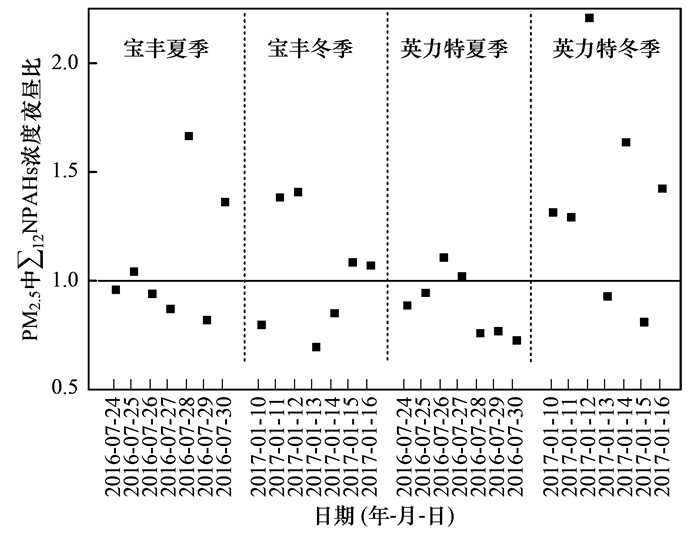
|
图 3 宝丰和英力特采样点PM2.5中Σ12NPAHs浓度夜昼比 Fig. 3 Nocturnal/diurnal concentrations ratios of Σ12NPAHsin PM2.5 from Baofeng and Yinglite |
有研究表明:一次排放的标识物N-PYR (1-硝基芘)与2N-FLO(2-硝基芴)和6N-CHR(6-硝基)浓度间存在较强的相关性[2], 由此2N-FLO、6N-CHR亦可以作为NPAHs一次排放的标识物[22~24].而2N-FLA, 因其只能由大气光化学反应形成[2, 22], 通常被视为二次形成源的标识物. Tomaz[25]的研究表明3N-PHE(3-硝基菲)也是一种大气PAHs氧化过程的标识物, 由此3N-PHE也为NPAHs二次形成的标识物.
图 4为冬夏两季宁东能源化工基地两采样点宝丰和英力特PM2.5中NPAHs的族谱特征.从中可以看出, 宝丰和英力特采样点夏冬季PM2.5中均以一次排放的2N-FLO、6N-CHR为主要占比, 其中宝丰采样点夏季2N-FLO和6N-CHR总占比为73%, 冬季为46%, 英力特采样点夏季总占为55%, 冬季为59%.其他贡献较大的组分还有7N-BaA, 其主要也来自于一次排放[26].宝丰采样点二次标识物2N-FLA夏季浓度平均占比为0.75%, 冬季为5.5%. 3N-PHE夏季浓度平均占比为5.5%, 冬季为2.5%.英力特采样点, 二次标识物2N-FLA夏季浓度平均占比为1.3%, 冬季为6.7%.值得注意的是, 英力特采样点夏季PM2.5中二次形成的标识物3N-PHE占比较高(21%), 远高于冬季(4%).推测可能原因为该采样点主要以化工产业为主, VOCs排放较高, 加之夏季光化学反应较强, O3浓度较高, 由此引发NPAHs二次形成[27].宝丰和英力特采样点冬季二次标识物2N-FLA浓度平均占比均为冬季高于夏季, 这可能与冬季燃煤取暖等造成的前体物NO2排放增多有关, 因为宝丰和英力特2N-FLA浓度与NO2浓度表现出了较强的相关性(r=0.63, P<0.01), Arey等[22]和Lin等[24]的研究也表明, NO2在PAHs转化为NPAHs过程中起重要作用.由此可见, 2个采样点冬夏季NPAHs主要来自于一次排放, 但冬夏季都存在二次形成源的贡献.
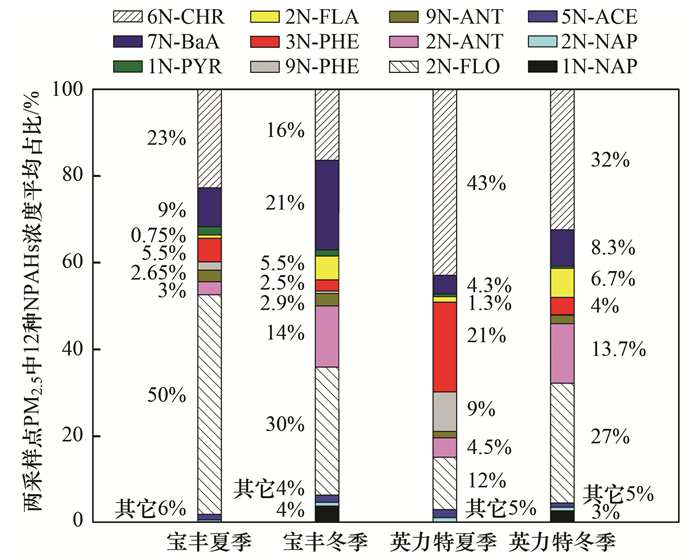
|
图 4 宝丰和英力特PM2.5中NPAHs的族谱季节性差异 Fig. 4 Congener profiles characteristics of NPAHs in PM2.5 from Baofeng and Yinglite |
通常NPAHs来源不仅有一次排放, 还有二次形成. NPAHs与其母体PAHs的浓度比值可用来初步识别其来源. ΣNPAHs/ΣPAHs比值通常用来识别NPAHs的二次形成源[28, 29], ΣNPAHs/ΣPAHs比值如果夏季高于冬季则表明夏季NPAHs部分来自于二次光化学反应.研究表明, 西安和中国北部城市NPAHs/PAHs比值均夏季高于冬季, 表明该研究区夏季较强的光化学反应促进NPAHs的二次形成[14, 30].
图 5为PM2.5中Σ12NPAHs与Σ16PAHs的浓度比值特征, 从中可以看出, 宝丰采样点冬季Σ12NPAHs/Σ16PAHs浓度比值为0.08±0.01, 夏季为0.10±0.017, 英力特采样点冬季Σ12NPAHs/Σ16PAHs浓度比值为0.13±0.02, 夏季为0.19±0.024, 由此可见, 宁东能源化工基地两采样点的Σ12NPAHs/Σ16PAHs浓度比值均为夏季高于冬季, 说明尽管夏季NPAHs浓度较低, 但夏季较高的温度促进了PAHs的降解以及NPAHs的二次形成, 从而导致夏季较高的Σ12NPAHs/Σ16PAHs浓度比值.英力特采样点夏季Σ12NPAHs/Σ16PAHs浓度比值约为宝丰采样点的2倍, 进一步表明英力特采样点夏季较宝丰采样点贡献更多二次形成的NPAHs.
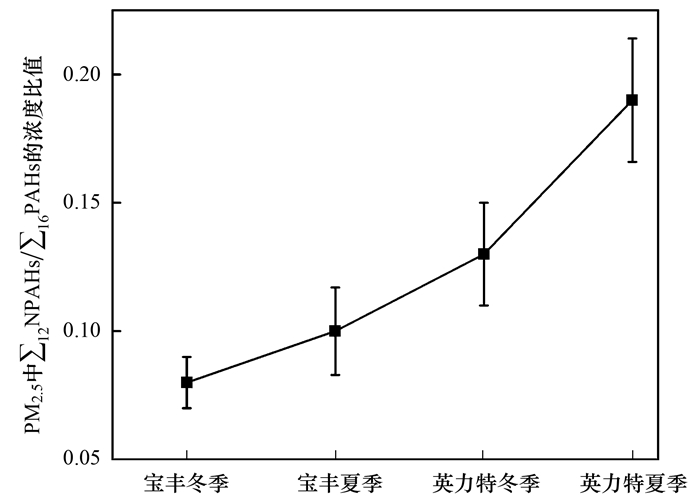
|
图 5 宝丰和英力特PM2.5中Σ12NPAHs/Σ16PAHs的浓度比值特征 Fig. 5 Ratio characteristics of Σ12NPAHs/Σ16PAHs in PM2.5 from Baofeng and Yinglite |
本文利用BaP(苯并[a]芘)等效毒性因子评价法对人群NPAHs呼吸暴露风险进行了评估.该方法主要利用各母体PAHs或其衍生物的等效毒性因子(toxicity equivalency factors, TEFs), 将不同的PAHs及其衍生物等效为相对于毒性最大的PAHs的BaP毒性当量, 由此再估算PAHs及其衍生物呼吸暴露致肺癌风险.本研究的12种目标NPAHs中仅5种有等效毒性因子TEFs数据(5N-ACE、2N-FLO、2N-FLA、1N-PYR和6N-CHR), 如表 2所示, 因此, 本研究采用该5种NPAHs对PM2.5中NPAHs的呼吸暴露肺癌风险进行了评估.
|
|
表 2 5种NPAHs等效于BaP的TEFs值 Table 2 BaP equivalent toxicity factors of five NPAHs |
NPAHs的等效毒性当量的计算公式如下:

|
式中, BaPeq为等效苯并[a]芘浓度, n为某一NPAH组分在PM2.5上的浓度, 单位为ng·m-3, TEF为该组分等效于BaP的毒性因子.
NPAHs个体呼吸暴露肺癌风险值的计算公式如下:

|
式中, 转换因子=0.001 μg·ng-1; 风险系数=1.1×10-3(μg·m-3)-1
将计算所得的个体肺癌风险值与美国加州环保署(California Environmental Protection Agency, Cal/EPA)规定的风险限值(等当量个体呼吸暴露肺癌风险限值为1.00×10-5)[31]进行比较, 从而判断该能源基地大气PM2.5中NPAHs对暴露人群是否带来健康威胁.
图 6为PM2.5中Σ5NPAHs呼吸暴露肺癌风险, 从中可知, PM2.5中Σ5NPAHs的肺癌风险也表现出相应地季节性差异, 宝丰PM2.5中Σ5NPAHs冬季肺癌风险值为3.06×10-5±1.36×10-5, 夏季为1.79×10-5±0.80×10-5.英力特冬季为2.85×10-5±1.20×10-5, 夏季为1.86×10-5±0.83×10-5.两采样点Σ5NPAHs的肺癌风险值均为冬季高于夏季, 冬季宝丰Σ5NPAHs的肺癌风险值略高于英力特, 体现了宝丰产业冬季的一次排放对NPAHs致癌风险的贡献; 而夏季却略低于英力特, 表明英力特化工产业前体物排放在夏季对二次形成NPAHs致癌风险有更高的贡献.但两采样点的PM2.5中Σ5NPAHs的肺癌风险值均大于1.00×10-5.由此判断宁东能源化工基地人群存在一定程度的大气PM2.5中NPAHs呼吸暴露肺癌风险.
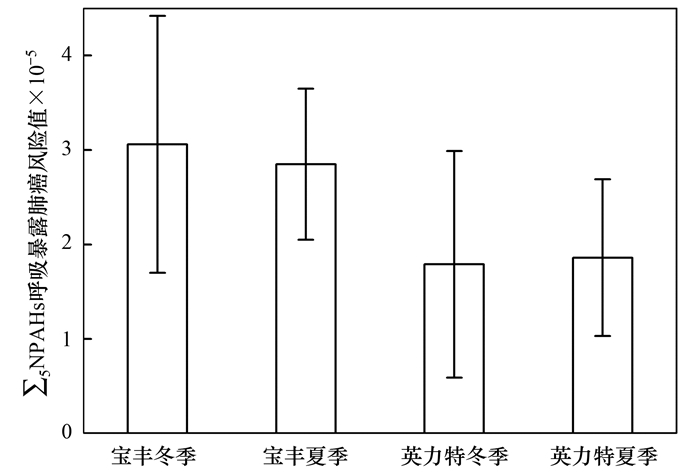
|
图 6 宝丰和英力特PM2.5中Σ5NPAHs呼吸暴露肺癌风险值 Fig. 6 Inhalation exposure lung cancer risk values for Σ5NPAHs in PM2.5 from Baofeng and Yinglite |
(1) 宁东能源化工基地大气PM2.5中NPAHs浓度水平特征:宝丰NPAHs浓度水平高于英力特.两个采样点NPAHs浓度均为冬季高于夏季.
(2) 宁东能源化工基地大气PM2.5中NPAHs夜昼变化特征:宝丰和英力特大部分采样天夏季NPAHs日间高于夜间, 而冬季则相反, 表明夏季日间NPAHs二次反应较夜间更活跃, 从而贡献更多二次形成的NPAHs.
(3) 宁东能源化工基地大气PM2.5中NPAH族谱特征:PM2.5中NPAHs族谱特征主要表现2N-FLO和6N-CHR占比较高, 因此宝丰和英力特冬夏季NPAHs均主要来自一次排放, 但冬夏季均存在二次形成源的贡献.
(4) 宁东能源化工基地大气PM2.5中Σ12NPAHs/Σ16PAHs比值变化特征:PM2.5中Σ12NPAHs/Σ16PAHs浓度比值夏季高于冬季, 说明夏季存在一定的二次反应形成的NPAHs对整体浓度水平的贡献.
(5) 宁东能源化工基地大气PM2.5中NPAHs呼吸暴露肺癌风险:PM2.5中NPAHs的呼吸暴露肺癌风险值高于Cal/EPA的1.00×10-5风险限值, 该基地人群有潜在的暴露于PM2.5中Σ5NPAHs致肺癌健康风险.
| [1] | Durant J L, Busby Jr W F, Lafleur A L, et al. Human cell mutagenicity of oxygenated, nitrated and unsubstituted polycyclic aromatic hydrocarbons associated with urban aerosols[J]. Mutation Research/Genetic Toxicology, 1996, 371(3-4): 123-157. DOI:10.1016/S0165-1218(96)90103-2 |
| [2] | Albinet A, Leoz-Garziandia E, Budzinski H, et al. Polycyclic aromatic hydrocarbons (PAHs), nitrated PAHs and oxygenated PAHs in ambient air of the Marseilles area (South of France):concentrations and sources[J]. Science of the Total Environment, 2007, 384(1-3): 280-292. DOI:10.1016/j.scitotenv.2007.04.028 |
| [3] | Wu S P, Yang B Y, Wang X H, et al. Diurnal variation of nitrated polycyclic aromatic hydrocarbons in PM10 at a roadside site in Xiamen, China[J]. Journal of Environmental Sciences, 2012, 24(10): 1767-1776. DOI:10.1016/S1001-0742(11)61018-8 |
| [4] | Huang B, Liu M, Bi X H, et al. Phase distribution, sources and risk assessment of PAHs, NPAHs and OPAHs in a rural site of Pearl River Delta region, China[J]. Atmospheric Pollution Research, 2014, 5(2): 210-218. DOI:10.5094/APR.2014.026 |
| [5] | Chen S C, Liao C M. Health risk assessment on human exposed to environmental polycyclic aromatic hydrocarbons pollution sources[J]. Science of the Total Environment, 2006, 366(1): 112-123. DOI:10.1016/j.scitotenv.2005.08.047 |
| [6] | Peng C, Chen W P, Liao X L, et al. Polycyclic aromatic hydrocarbons in urban soils of Beijing:status, sources, distribution and potential risk[J]. Environmental Pollution, 2011, 159(3): 802-808. DOI:10.1016/j.envpol.2010.11.003 |
| [7] | Wang W, Huang M J, Kang Y, et al. Polycyclic aromatic hydrocarbons (PAHs) in urban surface dust of Guangzhou, China:status, sources and human health risk assessment[J]. Science of the Total Environment, 2011, 409(21): 4519-4527. DOI:10.1016/j.scitotenv.2011.07.030 |
| [8] | Bandowe B A M, Meusel H. Nitrated polycyclic aromatic hydrocarbons (nitro-PAHs) in the environment-A review[J]. Science of the Total Environment, 2017, 581-582: 237-257. DOI:10.1016/j.scitotenv.2016.12.115 |
| [9] | 杨丹.东莞市大气颗粒物中NPAHs的污染特征及其对人体健康的影响评价[D].广州: 华南理工大学, 2012. |
| [10] |
林刚, 孙贵范, 唐宁, 等. 抚顺大气悬浮颗粒物、PAHs和NPAHs污染调查[J]. 中国公共卫生, 2005, 21(5): 604-606. Lin G, Sun G F, Tang N, et al. Analysis on concentrations of atmospheric particles and PAHs/NPAHs in Fushun[J]. Chinese Journal of Public Health, 2005, 21(5): 604-606. DOI:10.3321/j.issn:1001-0580.2005.05.045 |
| [11] | Ding J N, Zhong J J, Yang Y F, et al. Occurrence and exposure to polycyclic aromatic hydrocarbons and their derivatives in a rural Chinese home through biomass fuelled cooking[J]. Environmental Pollution, 2012, 169: 160-166. DOI:10.1016/j.envpol.2011.10.008 |
| [12] | Valle-Hernández B L, Mugica-álvarez V, Salinas-Talavera E, et al. Temporal variation of nitro-polycyclic aromatic hydrocarbons in PM10 and PM2.5 collected in Northern Mexico City[J]. Science of the Total Environment, 2010, 408(22): 5429-5438. DOI:10.1016/j.scitotenv.2010.07.065 |
| [13] | Kameda T, Takenaka N, Bandow H, et al. Determination of atmospheric nitro-polycyclic aromatic hydrocarbons and their precursors at a heavy traffic roadside and at a residential area in Osaka, Japan[J]. Polycyclic Aromatic Compounds, 2004, 24(4-5): 657-666. DOI:10.1080/10406630490471708 |
| [14] | Bandowe B A M, Meusel H, Huang R J, et al. PM2.5-bound oxygenated PAHs, nitro-PAHs and parent-PAHs from the atmosphere of a Chinese megacity:seasonal variation, sources and cancer risk assessment[J]. Science of the Total Environment, 2017, 473-474: 77-87. |
| [15] | Wang W, Jing L, Zhan J, et al. Nitrated polycyclic aromatic hydrocarbon pollution during the Shanghai World Expo 2010[J]. Atmospheric Environment, 2014, 89: 242-248. DOI:10.1016/j.atmosenv.2014.02.031 |
| [16] | Wang W T, Jariyasopit N, Schrlau J, et al. Concentration and photochemistry of PAHs, NPAHs, and OPAHs and toxicity of PM2.5 during the Beijing Olympic games[J]. Environmental Science & Technology, 2011, 45(16): 6887-6895. |
| [17] | Alam M S, Keyte I J, Yin J X, et al. Diurnal variability of polycyclic aromatic compound (PAC) concentrations:relationship with meteorological conditions and inferred sources[J]. Atmospheric Environment, 2015, 122: 427-438. DOI:10.1016/j.atmosenv.2015.09.050 |
| [18] | Wei S L, Huang B, Liu M, et al. Characterization of PM2.5-bound nitrated and oxygenated PAHs in two industrial sites of South China[J]. Atmospheric Research, 2012, 109-110: 76-83. DOI:10.1016/j.atmosres.2012.01.009 |
| [19] | Lafontaine S, Schrlau J, Butler J, et al. Relative influence of trans-pacific and regional atmospheric transport of PAHs in the Pacific Northwest, U. S.[J]. Environmental Science & Technology, 2015, 49(23): 13807-13816. |
| [20] | Teixeira E C, Garcia K O, Meincke L, et al. Study of nitro-polycyclic aromatic hydrocarbons in fine and coarse atmospheric particles[J]. Atmospheric Research, 2011, 101(3): 631-639. DOI:10.1016/j.atmosres.2011.04.010 |
| [21] | Ringuet J, Leoz-Garziandia E, Budzinski H, et al. Particle size distribution of nitrated and oxygenated polycyclic aromatic hydrocarbons (NPAHs and OPAHs) on traffic and suburban sites of a European megacity:Paris (France)[J]. Atmospheric Chemistry and Physics, 2012, 12(18): 8877-8887. DOI:10.5194/acp-12-8877-2012 |
| [22] | Arey J, Zielinska B, Atkinson R, et al. The formation of nitro-PAH from the gas-phase reactions of fluoranthene and pyrene with the OH radical in the presence of NOx[J]. Atmospheric Environment (1967), 1986, 20(12): 2339-2345. DOI:10.1016/0004-6981(86)90064-8 |
| [23] | Atkinson R, Arey J. Atmospheric chemistry of gas-phase polycyclic aromatic hydrocarbons: formation of atmospheric mutagens[J]. Environmental Health Perspectives, 1994, 102 Suppl 4: 117-126. |
| [24] | Lin Y, Qiu X H, Ma Y Q, et al. A novel approach for apportionment between primary and secondary sources of airborne nitrated polycyclic aromatic hydrocarbons (NPAHs)[J]. Atmospheric Environment, 2016, 138: 108-113. DOI:10.1016/j.atmosenv.2016.05.017 |
| [25] | Tomaz S, Jaffrezo J L, Favez O, et al. Sources and atmospheric chemistry of oxy-and nitro-PAHs in the ambient air of Grenoble (France)[J]. Atmospheric Environment, 2017, 61: 144-154. |
| [26] | Feilberg A, Nielsen T. Photodegradation of nitro-PAHs in viscous organic media used as models of organic aerosols[J]. Environmental Science & Technology, 2001, 35(1): 108-113. |
| [27] | Jia C H, Mao X X, Huang T, et al. Non-methane hydrocarbons (NMHCs) and their contribution to ozone formation potential in a petrochemical industrialized city, Northwest China[J]. Atmospheric Research, 2016, 169: 225-236. DOI:10.1016/j.atmosres.2015.10.006 |
| [28] | Garcia K O, Teixeira E C, Agudelo-Castañeda D M, et al. Assessment of nitro-polycyclic aromatic hydrocarbons in PM1 near an area of heavy-duty traffic[J]. Science of the Total Environment, 2014, 479-480: 57-65. DOI:10.1016/j.scitotenv.2014.01.126 |
| [29] | Tang N, Araki Y, Tamura K, et al. Distribution and source of atmospheric polycyclic aromatic hydrocarbons and nitropolycyclic aromatic hydrocarbons in Tieling City, Liaoning Province, a typical local city in Northeast China[J]. Asian Journal of Atmospheric Environment, 2009, 3(1): 52-58. DOI:10.5572/ajae.2009.3.1.052 |
| [30] | Li W, Wang C, Shen H Z, et al. Concentrations and origins of nitro-polycyclic aromatic hydrocarbons and oxy-polycyclic aromatic hydrocarbons in ambient air in urban and rural areas in northern China[J]. Environmental Pollution, 2015, 197: 156-164. DOI:10.1016/j.envpol.2014.12.019 |
| [31] | Collins J F, Brown J P, Alexeeff G V, et al. Potency equivalency factors for some polycyclic aromatic hydrocarbons and polycyclic aromatic hydrocarbon derivatives[J]. Regulatory Toxicology and Pharmacology, 1998, 28(1): 45-54. DOI:10.1006/rtph.1998.1235 |
 2019, Vol. 40
2019, Vol. 40


